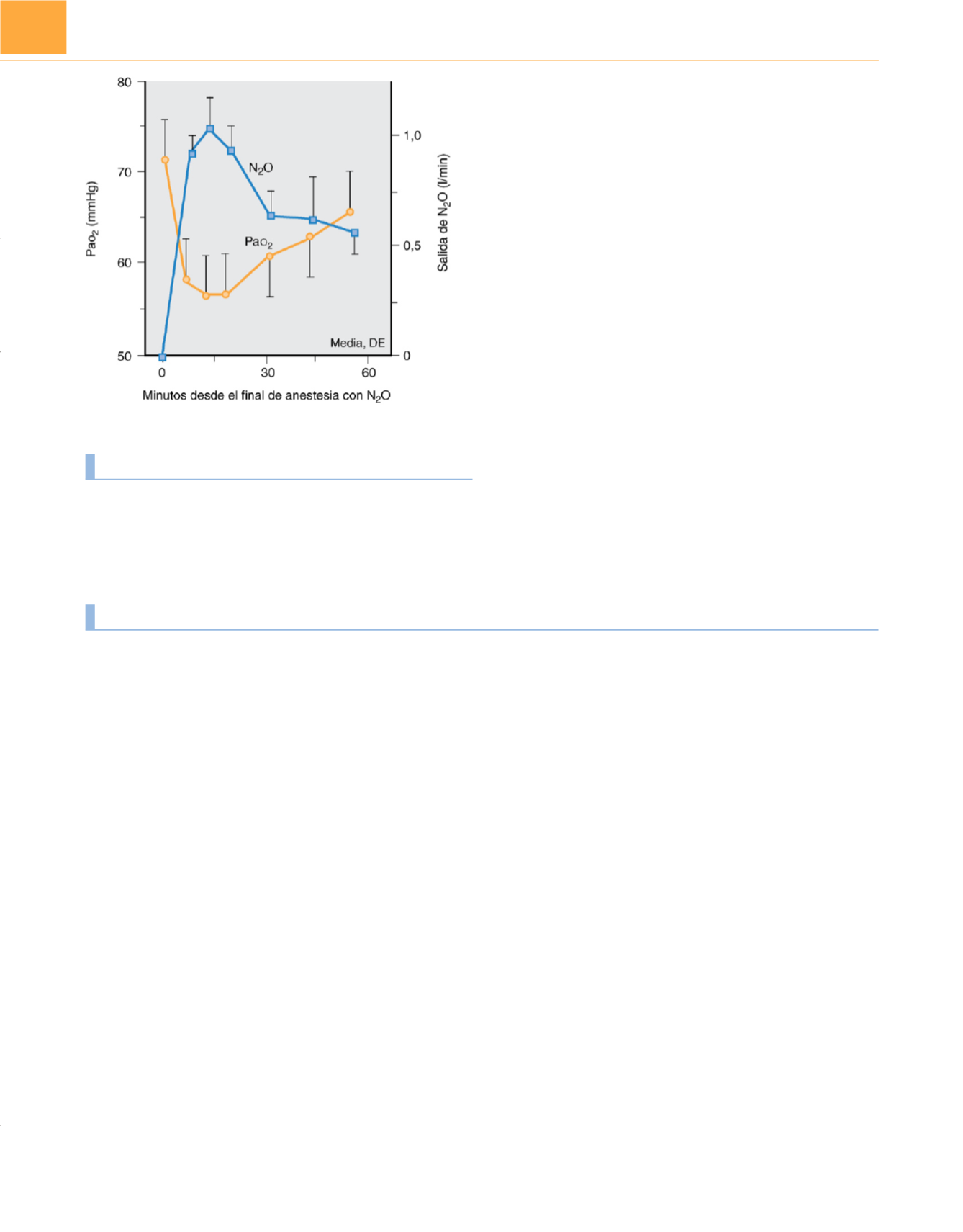

Impacto del circuito de anestesia
El circuito de anestesia puede limitar la velocidad de recuperación,
igual que limita la inducción. Si no se desconecta al paciente del
circuito al acabar el suministro de anestésico, el paciente puede
continuar inspirando anestésico. Para reducir la concentración ins-
pirada a cero o casi cero hay que tener en cuenta dos factores: lavar
el anestésico dentro del circuito y evitar que el paciente vuelva a
inspirar el aire exhalado que contiene anestésico. El efecto de cada
uno de estos factores para elevar la concentración de anestésico
inspirado puede corregirse con el uso de alta velocidad de flujo de
entrada de oxígeno (es decir,
≥
5 l/min).
Bibliografía
1. Eger EI II: Uptake of inhaled anesthetics: The alveolar
to inspired anesthetic difference.
In
Eger EI II (ed):
Anesthetic Uptake and Action. Baltimore,Williams &
Wilkins, 1974, pp 77–96.
2. Eger EI II: Partition coefficients of I-653 in human
blood, saline, and olive oil. Anesth Analg 66:971–973,
1987.
3. Eger RR, Eger EI II: Effect of temperature and age on
the solubility of enflurane, halothane, isoflurane and
methoxyflurane in human blood. Anesth Analg
64:640–642, 1985.
4. Eger EI II, Shargel RO, Merkel G: Solubility of diethyl
ether in water, blood and oil. Anesthesiology 24:676–
678, 1963.
5. Eger EI II, Shargel R: The solubility of methoxyflurane
in human blood and tissue homogenates.Anesthesio-
logy 24:625–627, 1963.
6. Cromwell TH, Eger EI II, Stevens WC, Dolan WM:
Forane uptake, excretion and blood solubility in man.
Anesthesiology 35:401–408, 1971.
7. Yasuda N, Targ AG, Eger EI II: Solubility of I-653,
sevoflurane, isoflurane, and halothane in human
tissues. Anesth Analg 69:370–373, 1989.
8. Lerman J, Schmitt-Bantel BI, Gregory GA, et al: Effect
of age on the solubility of volatile anesthetics in
human tissues. Anesthesiology 65:307–311, 1986.
9. Munson ES, Eger EI II, Bowers DL: Effects of anesthe-
tic-depressed ventilation and cardiac output on anes-
thetic uptake. Anesthesiology 38:251–259, 1973.
10. Yasuda N, Lockhart SH, Eger EI II, et al: Kinetics of
desflurane, isoflurane, and halothane in humans.
Anesthesiology 74:489–498, 1991.
11. Yasuda N, Lockhart SH, Eger EI II, et al: Comparison
of kinetics of sevoflurane and isoflurane in humans.
Anesth Analg 72:316–324, 1991.
12. Eger EI II: The effect of inspired concentration on the
rate of rise of alveolar concentration. Anesthesiology
24:153–157, 1963.
13. Stoelting RK,Eger EI II:An additional explanation for
the second gas effect: A concentrating effect.Anesthe-
siology 30:273–277, 1969.
14. Korman B,MaplesonWW: Concentration and second
gas effects: Can the accepted explanation be impro-
ved? Br J Anaesth 78:618–625, 1997.
15. Eger EI II, Smith RA, Koblin DD: The concentration
effect can be mimicked by a decrease in blood solu-
bility. Anesthesiology 49:282–284, 1978.
16. Epstein RM, Rackow H, Salanitre E, Wolf GL:
Influence of the concentration effect on the uptake of
anesthetic mixtures: The second gas effect. Anesthe-
siology 25:364–371, 1964.
17. Taheri S, Eger EI II: A demonstration of the concen-
tration and second gas effects in humans anesthetized
with nitrous oxide and desflurane. Anesth Analg
89:774–780, 1999.
18. Hendrickx JF, Carette R, Lemmens HJ, De Wolf AM:
Large volume N
2
O uptake alone does not explain the
second gas effect of N
2
O on sevoflurane during cons-
tant inspired ventilation. Br J Anaesth 96:391–395,
2006.
19. Cullen BF, Eger EI II: Diffusion of nitrous oxide,
cyclopropane, and halothane through human skin
and amniotic membrane.Anesthesiology 36:168–173,
1972.
20. Lockhart SH,Yasuda Y, Peterson N, et al: Comparison
of percutaneous losses of sevoflurane and isoflurane
in humans. Anesth Analg 72:212–215, 1991.
21. Fassoulaki A, Lockhart S, Freire BA, et al: Percuta-
neous loss of desflurane, isoflurane and halothane in
humans. Anesthesiology 74:479–483, 1991.
22. Laster MJ, Tahari S, Eger EI II, et al: Visceral losses of
desflurane, isoflurane, and halothane in swine.Anesth
Analg 73:209–212, 1991.
23. Carpenter RL,Eger EI II,Johnson BH,et al: The extent
of metabolism of inhaled anesthetics in humans.
Anesthesiology 65:201–205, 1986.
24. Carpenter RL, Eger EI II, Johnson BH, et al: Pharma-
cokinetics of inhaled anesthetics in humans: Measu-
rements during and after the simultaneous
administration of enflurane, halothane, isoflurane,
methoxyflurane, and nitrous oxide. Anesth Analg
65:575–582, 1986.
25. Carpenter RL, Eger EI II, Johnson BH, et al: Does the
duration of anesthetic administration affect the phar-
macokinetics or metabolism of inhaled anesthetics in
humans. Anesth Analg 66:1–8, 1987.
26. Halsey MJ, Sawyer DC, Eger EI II, et al: Hepatic meta-
bolism of halothane, methoxyflurane, cyclopropane.
Ethrane and Forane in miniature swine. Anesthesio-
logy 35:43–47, 1971.
27. Yamamura H, Wakasugi B, Okuma Y, Maki K: The
effects of ventilation on the absorption and elimina-
tion of inhalation anaesthetics. Anaesthesia 18:427–
438, 1963.
28. Fukui Y, Smith NT: Interactions among ventilation,
the circulation, and the uptake and distribution of
halothane—use of a hybrid computer multiple model:
I. The basic model. Anesthesiology 54:107–118,
1981.
29. Doi M, Ikeda K: Respiratory effects of sevoflurane.
Anesth Analg 66:241–244, 1987.
30. Fourcade HE, Stevens WC, Larson CP Jr, et al: The
ventilatory effects of Forane,a new inhaled anesthetic.
Anesthesiology 35:26–31, 1971.
31. Munson ES, Larson CP Jr, Babad AA, et al: The effects
of halothane, fluroxene and cyclopropane on ventila-
tion: A comparative study in man. Anesthesiology
27:716–728, 1966.
32. Lockhart S, Rampil IJ, Yasuda N, et al: Depression of
ventilation by desflurane in humans. Anesthesiology
74:484–488, 1991.
33. Yamamura H. The effect of ventilation and blood
volume on the uptake and elimination of inhalation
anesthetic agents.
In
Progress in Anaesthesiology.
324
Farmacología y anestesia
II
Figura 11-24
En el momento cero se cambió el gas inspirado de oxígeno 21%/
óxido nitroso 79% a oxígeno 21%/nitrógeno 79%. El oxígeno arterial descendió en
relación con la emanación de óxido nitroso.
(Modificada de Sheffer L, Steffenson
JL, Birch AA: Nitrous-oxide-induced diffusion hypoxia in patients breathing
spontaneously.
Anesthesiology
37:436-439, 1972.)









